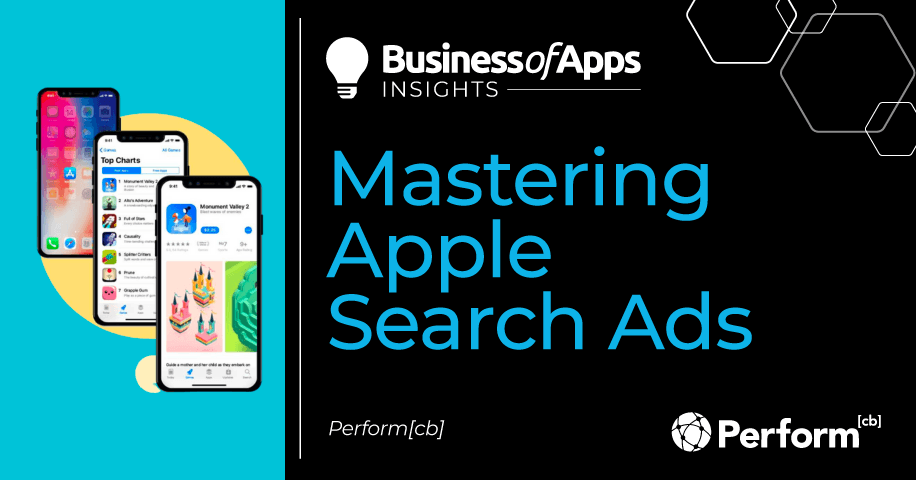Picture your daily life without a handful of trusty apps – no dodging traffic, no managing your schedule, and not being able to share your dreamy vacation photos. In reality, this is difficult to imagine, given that users spend about 90% of their mobile time using apps.
While consumers can feel at ease knowing there is an app for almost everything under the sun, capturing that user attention can be a challenging, competitive jungle for marketers. This is where Apple Search Ads come in. Let’s uncover how Apple Search Ads ensure your app finds the right audience.
What are Apple Search Ads?
Apple Search Ads empower mobile marketers to effectively boost their app’s visibility and performance across the App Store. AppFigures data confirms the impact of this advertising channel, with 61% of the top apps running these ads.
Apple Search Ads secure prime positions in the App Store’s search results, putting apps front and center for qualified users actively searching. Holding a top position is vital, considering 70% of App Store visitors use search to discover new apps.
What makes Apple Search Ads particularly valuable is their targeting precision based on trending keywords and user demographics. This focused approach ensures that ads are displayed to only the most relevant audience, further increasing the likelihood of conversion, as 65% of downloads happen directly after a search.
Basic vs. Advanced Apple Search Ads
When setting up Apple Search Ads, app marketers will encounter two options: Basic and Advanced.
The Basic version is perfect for new marketers with a hassle-free way to get ads up and running, as Apple’s automation handles keywords and targeting. Marketers have the flexibility to set their desired spend, and the system matches the ads with relevant users automatically.
The Advanced version is the preferred choice for those craving greater control, transparency, and precision in their user acquisition campaigns. It provides extensive customization, allowing marketers to handpick their ideal target audience and keywords, manage ad exposure, and leverage a variety of creative assets. Opting for Advanced enables brands to position their ads either in the search tab or at the top of the search results. Additionally, marketers can implement Discovery campaigns to uncover new trending keywords and reach untapped audiences.
Apple Search Ads Campaign Structure
When constructing Apple Search Ads campaigns, it’s recommended to split the desired keywords into categories so marketers can manage and set goals for them accordingly.
CTV Growth Guide: A must-read for performance marketers
Whether you’re looking to boost brand awareness or drive user acquisition, this guide has you covered. Learn how to leverage CTV for both brand awareness and performance-driven campaigns and get actionable insights to optimize your strategies.
Download nowFor a solid foundation, consider these four categories:
- Brand Campaign: List all the different ways users could search for your brand, including misspellings and spacing variations.
- Competitor Campaign: Identify apps similar to yours and rival brands targeting the same audience.
- Generic Keywords Campaign: Gather all generic terms users may use when searching for your app, including descriptive phrases and the issues your app resolves.
- Discovery Campaign: Let Apple Search Ads pick your keywords based on your app’s metadata. Then, analyze what your users are searching for and add those keywords to your list.
Learn how Perform[cb] leveraged a strategic keyword campaign to catapult a popular gaming app to the #1 spot in app store rankings, resulting in a remarkable 72% increase in overall app ranking.
Apple Search Ads Targeting Best Practices
To maximize the effectiveness of Apple Search Ads, it’s wise to employ precise targeting strategies.
Here are six tactics to efficiently reach and engage your desired audience:
- Search Match Targeting: Apple Search Ads Advanced offers a feature called Search Match, which automatically matches an ad with relevant search terms, saving time and money.
- Keyword Targeting: Advertisers can bid on keywords, similar to PPC ads. Options include broad match, exact match, and negative keyword matching.
- Customer Types Targeting: Target users based on their interactions with your app, such as all App Store users, new users, returning users, or users of your other apps.
- Demographic Targeting: Target users based on age and gender, but note that ads won’t be shown to children under 13.
- Device Type Targeting: Adjust bids and criteria based on device type or show specific ads only on iPads or iPhones, allowing for precise targeting.
- Location Targeting: While not available everywhere, location targeting helps region-specific apps and services connect with local users.
Improve App Store Optimization (ASO) with Apple Search Ads
App Store Optimization (ASO) and Apple Search Ads go hand in hand as their collaboration significantly impacts user acquisition success. ASO data plays a pivotal role in identifying and optimizing towards potential keywords for Apple Search Ads campaigns. It helps evaluate keyword performance on the App Store, aligns with user queries, identifies trends, and enhances campaign creatives.
On the other hand, insights from Apple Search Ads campaigns can be leveraged to fine-tune your app listing page, strengthening ASO performance as a result. For instance, identifying keywords with high conversion rates through Apple Search Ads suggests their relevance to user search intent. By incorporating these high-converting keywords into your app’s metadata, you can boost organic keyword rankings and visibility. This improved ASO performance, in turn, bolsters your Apple Search Ads campaign performance – who doesn’t love a win-win?
Discover more about the benefits ASO campaigns offer to mobile marketers like yourself.
Embracing Apple Search Ads
Apple Search Ads offer a valuable opportunity for marketers to enhance their app’s visibility, attract a relevant audience, and optimize the overall app store presence. By understanding the basics and implementing powerful strategies into your mobile marketing strategy, you’ll watch your app climb the rankings.
Ready to scale your app installs with a team of user acquisition experts? Let’s get started.












